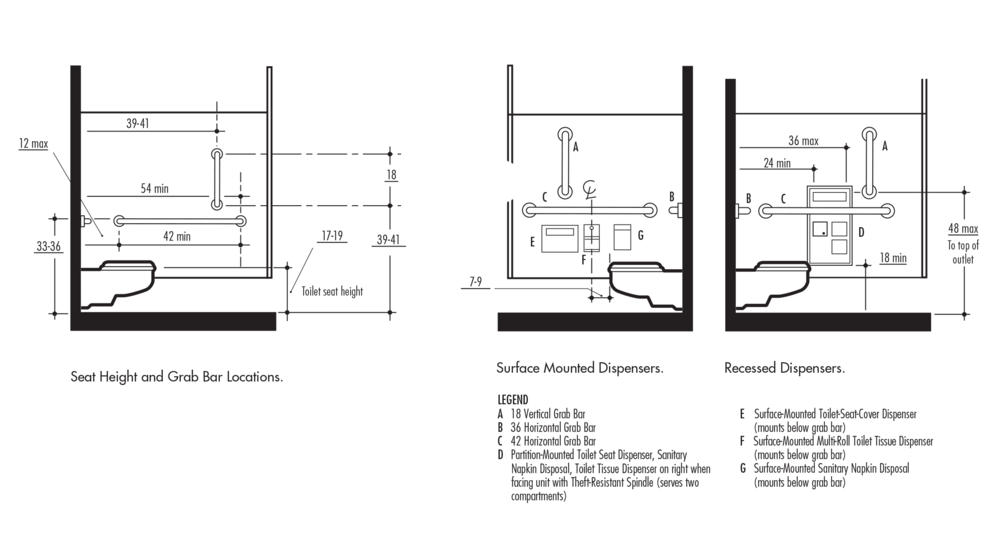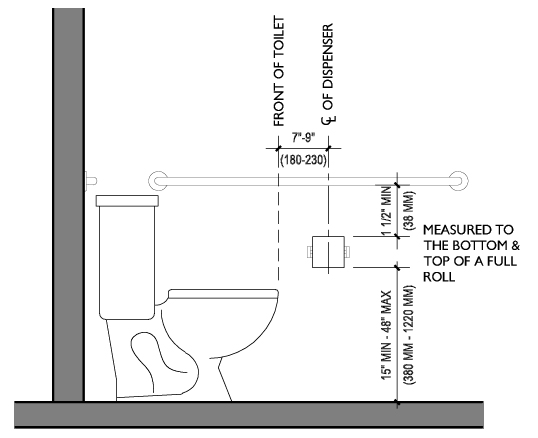ADA Bathroom Accessibility Standards
Creating accessible bathrooms is crucial for ensuring equal access and comfort for all individuals, including those with disabilities. The Americans with Disabilities Act (ADA) sets forth specific guidelines and standards to ensure that public bathrooms are accessible to everyone. Compliance with ADA regulations not only promotes inclusivity but also enhances usability and safety in public spaces.
- Understanding ADA Regulations: The ADA provides comprehensive guidelines for various aspects of bathroom accessibility, including door width, stall size, grab bar placement, and fixture heights. These standards aim to remove barriers and facilitate independent use of bathroom facilities by individuals with disabilities.
- Features of ADA-compliant Bathrooms: ADA-compliant bathrooms feature wider doorways to accommodate wheelchairs, grab bars for support and stability, accessible sinks and toilets, as well as adequate space for maneuverability. These features are designed to enhance accessibility and promote a positive experience for all users.
- Benefits of Compliance: Compliance with ADA standards not only ensures legal adherence but also fosters inclusivity and social responsibility. By providing accessible bathrooms, businesses and organizations demonstrate their commitment to diversity and inclusion, which can enhance their reputation and attract a broader customer base.
- Challenges and Solutions: While implementing ADA-compliant bathrooms may pose challenges such as space limitations or retrofitting existing facilities, creative solutions exist to overcome these obstacles. Designing multi-functional spaces, utilizing adjustable fixtures, and seeking professional guidance can help address accessibility concerns effectively.
- Continuous Improvement: As technology advances and societal perceptions evolve, the concept of accessibility continues to evolve. Regular audits and updates to bathroom facilities are essential to ensure ongoing compliance with ADA standards and to meet the changing needs of diverse user groups.

Importance of ADA Bathroom Accessories Mounting Heights
Proper installation of bathroom accessories at appropriate heights is essential to ensure accessibility and usability for individuals with disabilities. The mounting heights of ADA bathroom accessories are specified to accommodate users of varying abilities and to comply with ADA regulations. Understanding the importance of these mounting heights is crucial for designing accessible and inclusive bathroom spaces.
Enhanced Accessibility: Mounting bathroom accessories such as grab bars, toilet paper dispensers, and mirrors at ADA-compliant heights enhances accessibility for individuals with disabilities. These standardized heights ensure that users can reach and utilize these fixtures comfortably and safely.
Promoting Independence: Accessible mounting heights empower individuals with disabilities to perform daily tasks independently, without assistance from others. By placing fixtures within reach and providing support where needed, bathroom accessories contribute to a greater sense of autonomy and dignity for users.
Preventing Accidents and Injuries: Properly mounted bathroom accessories help prevent accidents and injuries by providing stability and support for users. Grab bars at appropriate heights reduce the risk of falls, while accessible toilet paper dispensers and mirrors improve usability and convenience.
Legal Compliance: Adhering to ADA mounting height standards is not only a matter of convenience and safety but also a legal requirement for public facilities. Failure to comply with these regulations can result in legal repercussions and penalties, highlighting the importance of proper installation and adherence to standards.
User Experience: Consideration of mounting heights is essential for optimizing the user experience in bathroom design. By ensuring that fixtures are positioned at comfortable and accessible heights, designers can create spaces that accommodate the diverse needs of all users, regardless of ability.
General Guidelines for ADA Bathroom Accessories Mounting Heights
When designing or renovating bathrooms to comply with ADA regulations, it’s essential to understand the general guidelines for mounting heights of various bathroom accessories. These guidelines ensure that fixtures are positioned at appropriate heights to accommodate users of all abilities and promote accessibility and safety.
Grab Bars: Grab bars should be mounted between 33 and 36 inches above the finished floor. Horizontal grab bars should be at least 42 inches long, while vertical grab bars should extend from a point 9 inches in front of the toilet to 3 inches behind it.
Toilet Paper Dispensers: Toilet paper dispensers should be mounted between 19 and 36 inches above the finished floor. The dispenser should be located within easy reach of the toilet and positioned to allow for comfortable use by individuals of varying heights and abilities.
Sink and Vanity: The rim or counter of a sink or vanity should be no higher than 34 inches above the finished floor. This allows individuals using wheelchairs to comfortably access the sink and mirrors without obstruction.
Mirrors: Mirrors should be mounted with the bottom edge no higher than 40 inches above the finished floor. This ensures that individuals of average height and those using wheelchairs can easily see themselves in the mirror.
Hand Dryers: Hand dryers should be mounted no higher than 48 inches above the finished floor to accommodate users of varying heights. Additionally, hand dryers should be positioned to allow for easy access and operation by individuals with disabilities.
Specific Mounting Heights for Different ADA Bathroom Accessories
When it comes to ADA compliance in bathroom design, specific mounting heights for various accessories are crucial to ensure accessibility and usability for individuals with disabilities. These mounting heights are standardized to accommodate users of different abilities and to provide support and convenience where needed. Understanding the specific requirements for each type of accessory is essential for designing accessible and inclusive bathroom spaces.
Grab Bars: Horizontal grab bars should be mounted between 33 and 36 inches above the finished floor, with a diameter between 1.25 and 1.5 inches for a comfortable grip. Vertical grab bars, typically installed near toilets, should extend from a point 9 inches in front of the toilet to 3 inches behind it, with the top of the bar between 33 and 36 inches above the finished floor.
Toilet Paper Dispensers: Toilet paper dispensers should be mounted between 19 and 36 inches above the finished floor to ensure accessibility for individuals of varying heights and abilities. The dispenser should be positioned within easy reach of the toilet and installed securely to prevent accidental dislodging.
Sink and Vanity: The rim or counter of a sink or vanity should be no higher than 34 inches above the finished floor to accommodate individuals using wheelchairs. Additionally, knee clearance of at least 27 inches high, 30 inches wide, and 19 inches deep should be provided below the sink to allow wheelchair users to approach the sink comfortably.
Mirrors: Mirrors should be mounted with the bottom edge no higher than 40 inches above the finished floor to ensure visibility for individuals of average height and those using wheelchairs. Tilted or adjustable mirrors can further enhance accessibility by allowing users to adjust the angle for optimal viewing.
Hand Dryers: Hand dryers should be mounted no higher than 48 inches above the finished floor to accommodate users of varying heights, including those using wheelchairs. Additionally, hand dryers should be positioned to allow for easy access and operation by individuals with disabilities, with clear floor space provided in front of the dryer for maneuverability.
How to Ensure Compliance with ADA Regulations in Bathroom Design
Designing bathrooms that comply with ADA regulations requires careful planning and attention to detail. From layout and fixture placement to material selection and installation, every aspect of bathroom design plays a role in ensuring accessibility and usability for individuals with disabilities. Here are some key steps to ensure compliance with ADA regulations in bathroom design:
Familiarize Yourself with ADA Guidelines: Start by familiarizing yourself with the ADA Standards for Accessible Design, which outline specific requirements for various aspects of bathroom design, including layout, clearances, and fixture heights. Understanding these guidelines is essential for ensuring compliance throughout the design process.
Consult with Accessibility Experts: Consider consulting with accessibility experts or ADA consultants who can provide guidance and expertise on designing accessible bathrooms. These professionals can help identify potential barriers and recommend solutions to ensure compliance with ADA regulations.
Consider User Needs and Preferences: Take into account the needs and preferences of diverse user groups, including individuals with disabilities, elderly individuals, and parents with young children. By considering the needs of all users, you can design bathrooms that are inclusive and accommodating for everyone.
Plan Layout and Clearances: Design bathroom layouts that provide ample maneuvering space for individuals using wheelchairs or mobility aids. Ensure that doorways are wide enough to accommodate wheelchairs, and provide clear floor space in front of fixtures for easy access.
Select ADA-compliant Fixtures and Accessories: Choose fixtures and accessories that meet ADA requirements for height, reach, and operation. This includes selecting toilets with appropriate seat heights, sinks with knee clearance, and grab bars with secure mounting.
Regular Inspections and Maintenance: Conduct regular inspections of bathroom facilities to ensure that they remain compliant with ADA regulations over time. Address any issues or deficiencies promptly, and schedule regular maintenance to keep fixtures and accessories in good working condition.
Tips for Properly Installing ADA Bathroom Accessories
Proper installation of ADA bathroom accessories is crucial for ensuring accessibility, safety, and compliance with ADA regulations. Whether you’re retrofitting existing facilities or designing new bathrooms, following best practices for installation can help optimize usability and enhance the overall user experience. Here are some tips for properly installing ADA bathroom accessories:
Follow ADA Guidelines: Familiarize yourself with the ADA Standards for Accessible Design, which provide detailed guidelines for the installation of bathroom accessories such as grab bars, toilet paper dispensers, and mirrors. Ensure that accessories are positioned at the appropriate heights and locations to comply with ADA regulations.
Use Proper Mounting Hardware: Use high-quality mounting hardware that is suitable for the material and load requirements of the accessory being installed. Securely anchor grab bars and other fixtures to structural supports to ensure stability and durability over time.
Ensure Adequate Clearance: Provide ample clearance around bathroom accessories to allow for easy access and maneuverability, particularly for individuals using wheelchairs or mobility aids. Avoid installing accessories in cramped or confined spaces that may inhibit usability.
Consider User Preferences: Take into account the preferences and needs of diverse user groups when installing bathroom accessories. For example, consider installing adjustable-height shower heads or hand-held shower wands to accommodate users of varying heights and abilities.
Optimize Placement: Position bathroom accessories at convenient locations within easy reach of users, taking into account factors such as reach distances and line of sight. Ensure that grab bars are installed in areas where users are likely to need support, such as near toilets and showers.
Regular Maintenance: Schedule regular inspections and maintenance of bathroom accessories to ensure that they remain in good working condition and comply with ADA regulations over time. Address any issues or deficiencies promptly to maintain accessibility and safety for users.
Accessories in Public Restrooms ADA Guidelines
ADA Bathroom Requirements: Toilet Height, Grab Bars, Stall
Public Restrooms ADA Guidelines
ADA Compliant Bathroom: Sinks and Restroom Accessories
CE Center –
How to Design an ADA Restroom Arch Exam Academy
Related Posts:










